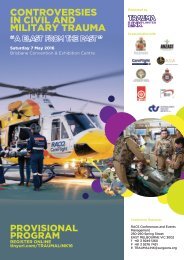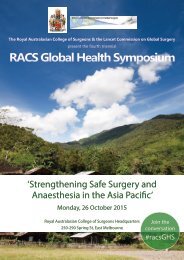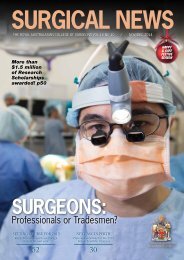Create successful ePaper yourself
Turn your PDF publications into a flip-book with our unique Google optimized e-Paper software.
THE BYSTANDER EFFECT<br />
Dr Lipi Shukla’s research will help treatment for those who have cell damage<br />
from radiotherapy cancer treatments<br />
Plastic and Reconstructive Surgery Trainee Dr Lipi<br />
Shukla has spent the past three years investigating<br />
the cellular and molecular causes, and progression of,<br />
the damage done to healthy nearby tissue by radiotherapy<br />
cancer treatments, a condition known as Radiation Induced<br />
Bystander Effect (RIBE).<br />
Considered an inevitable side-effect of radiotherapy, RIBE<br />
is a progressive, late-onset soft-tissue injury that can expose<br />
vital underlying structures and is characterised by symptoms<br />
including pain, contracture, tissue breakdown, recurrent<br />
infection and lymphoedema.<br />
With improvements in cancer treatments and the<br />
consequent cohort of cancer survivors growing year by<br />
year, RIBE is now presenting as both a significant quality<br />
of life issue for such patients and an increasing challenge to<br />
surgeons across all specialties.<br />
It is now part of a growing list of ailments called “diseases of<br />
survivorship”.<br />
Dr Shukla said that RIBE-affected tissue had a restricted<br />
ability to redevelop a new blood supply and recover from<br />
injury, which restricts surgical treatments particularly in<br />
such specialties as Plastic and Reconstructive Surgery, ENT,<br />
General Surgery and Colon Surgery.<br />
“Important implications of RIBE for surgeons are that<br />
surgical procedures – whether for functional restoration<br />
or cancer recurrence – in irradiated tissues are made more<br />
difficult,” Dr Shukla said.<br />
“Direct wound closure or local flaps are restricted by stiff,<br />
non-compliant tissue and even if wound edges are opposable,<br />
they are frequently subject to poor wound healing or<br />
breakdown.<br />
“The ability of an irradiated wound bed to accept a skin<br />
graft is also diminished, which often necessitates more<br />
complex, potentially hazardous reconstructive procedures<br />
such as free microvascular tissue transfer from distant sites, in<br />
which radiation is a chief contributing factor to poor patient<br />
outcomes.<br />
“Methods to salvage irradiated tissues to a point at which<br />
soft-tissue quality permits simple wound or tissue repair is<br />
desperately needed by clinicians.”<br />
Dr Shukla undertook the research into RIBE as part of a<br />
PhD through the Australian Catholic University, St Vincent’s<br />
Hospital in Melbourne and the O’Brien Institute of Tissue<br />
Engineering with financial support from the College as the<br />
first recipient of the Foundation for Surgery Tour de Cure<br />
Cancer Research Scholarship.<br />
Not only did she set out to understand the effects of<br />
radiotherapy injury on cell function in-vitro and the role such<br />
alterations played in the development of lymphoedema and<br />
fibrosis but also to find out if there was scientific evidence to<br />
support anecdotal reports that fat grafts could ameliorate the<br />
effects of RIBE.<br />
“For some time, Plastic and Reconstructive Surgeons,<br />
particularly those conducting breast reconstruction<br />
surgeries following mastectomy, were anecdotally reporting<br />
that irradiated tissue overlying the fat graft became more<br />
complaint and less lymphoedematous,” Dr Shukla said.<br />
“While these effects had been clinically validated in murine<br />
models, the scientific mechanisms behind the phenomenon<br />
remained poorly understood so I wanted to find out why this<br />
was happening.<br />
“As part of this research, we broke down RIBE effected tissue<br />
to the cellular level to understand the molecular signalling<br />
changes that were taking place in damaged cells, while also<br />
trying to identify growth factors that may reverse the effects.”<br />
Dr Shukla said she investigated adipose derived stem cells,<br />
extracted from samples of excess fat and found that these cells<br />
secreted specific growth factors that were able to reverse the<br />
“Important implications of RIBE<br />
for surgeons are that surgical<br />
procedures – whether for<br />
functional restoration or cancer<br />
recurrence – in irradiated tissues<br />
are made more difficult.”<br />
effects of radiotherapy injury on cells such as fibroblasts and<br />
lymphatic endothelial cells.<br />
Another series of laboratory experiments investigating the<br />
effects of irradiation on normal human dermal fibroblasts,<br />
indicated that it resulted in a hyperactivity, rather than<br />
suppression of certain physiological functions<br />
“This was a significant finding because it suggests that this<br />
hyper-active state represents cellular dysfunction resulting<br />
from sub-lethal radiotherapy injury and that it could be a<br />
contributing factor to the formation of fibrosis and the spread<br />
of RIBE rather than the more traditional hypotheses of large<br />
scale cell death,” Dr Shukla said.<br />
“We also found in our model of fat grafting that<br />
hyperactivity of irradiated normal human dermal fibroblasts<br />
was reduced and reversed in the presence of growth factors<br />
secreted by adipose derived stem cells.<br />
“We now believe that these stem cells have great regenerative<br />
potential and aim to identify specific growth factors that can<br />
reduce the effects of radiotherapy injury in a cell-specific<br />
manner.<br />
“It was very exciting to build up a scientific base which<br />
supports the anecdotal evidence that has been the subject<br />
of increasing interest in Plastic and Reconstructive Surgery<br />
literature for the last decade.”<br />
Dr Shukla conducted her research under the supervision of<br />
Professor Wayne Morrison, the former Director of the O’Brien<br />
SUCCESSFUL<br />
SCHOLAR<br />
Institute, and Mr Ramin Shayan, the current Director of the<br />
Institute.<br />
She is now back at work as a SET1 Plastic and<br />
Reconstruction Registrar at the Maroondah and Box Hill<br />
Hospitals in Melbourne.<br />
Now in the process of writing up her thesis, Dr Shukla<br />
thanked the College and Tour de Cure Foundation for the<br />
generous support given to her to complete her research.<br />
“It is always a difficult decision to take time away from<br />
training to dedicate to research, but this area of medicine is of<br />
great intellectual and clinical interest to me. It has given me<br />
the opportunity to develop a set of skills facilitating bedside<br />
to lab bench research, seeing the problems in clinic and trying<br />
to find a scientific solution to the problems faced by our<br />
patients,” she said.<br />
“This PhD has allowed me to acquire expertise in the<br />
rapidly evolving area of fat grafting and radiotherapy injury,<br />
with the hopes to discover novel and targeted ways to restore<br />
normality to the lives of patients who have already been<br />
through the pain and discomfort of cancer treatments.<br />
“It was also rewarding to be able to contribute to a surgical<br />
specialty that I will be working in for the rest of my life and<br />
I hope to incorporate ongoing contributions to translational<br />
research, tissue engineering and regenerative surgery<br />
throughout my surgical career.”<br />
The Foundation for Surgery Tour de Cure Cancer Research<br />
Scholarship was established in 2014 and provides a stipend<br />
and departmental maintenance for Fellows, Trainees and<br />
International Medical Graduates wishing to undertake a<br />
cancer research project.<br />
With Karen Murphy<br />
30 <strong>SURGICAL</strong> <strong>NEWS</strong> APRIL 2016 <strong>SURGICAL</strong> <strong>NEWS</strong> APRIL 2016 31






